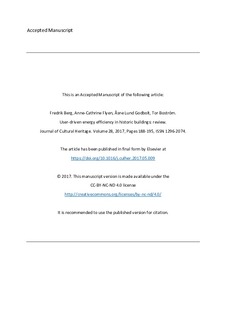| dc.contributor.author | Berg, Fredrik | |
| dc.contributor.author | Flyen, Anne Cathrine | |
| dc.contributor.author | Godbolt, Åsne Lund | |
| dc.contributor.author | Broström, Tor | |
| dc.date.accessioned | 2019-01-23T15:34:51Z | |
| dc.date.available | 2019-01-23T15:34:51Z | |
| dc.date.created | 2017-05-16T11:52:56Z | |
| dc.date.issued | 2017 | |
| dc.identifier.citation | Journal of Cultural Heritage. 2017, 28, 188-195. | nb_NO |
| dc.identifier.issn | 1296-2074 | |
| dc.identifier.issn | 1778-3674 | |
| dc.identifier.uri | http://hdl.handle.net/11250/2582015 | |
| dc.description.abstract | The paper draws from the general literature on energy efficiency and historic buildings to explain the importance and potential of user-driven energy efficiency in historic buildings. It is the first review that places the user as a central object of study in the research field of historic buildings and energy efficiency. Relevant interdisciplinary topics and research results that make up the core of the field are presented and discussed in relation to user behaviour and its impact on energy consumption. The paper also investigates how user behaviour aspects can be integrated in a procedural approach to energy refurbishment in historic buildings.
Research and experience from the building stock in general clearly shows how a user's awareness and behaviour, such as choice of temperature, zone heating and controlled airing, can have a significant effect on energy demand yet have no physical impact on the building. However, this has not received enough attention with regards to the historic building stock, where many physical energy efficiency measures can have negative impacts on the historic qualities of the building. Modification of user behaviour can therefore be a way not only to reduce energy demand but also to minimise the physical impact of increasing energy efficiency on historic buildings.
The paper concludes that the current research agenda on historic buildings and energy efficiency has broken much ground but remains focused more on technical solutions than bottom-up user perspectives. Two main topics are identified as key barriers and future research fields: First, energy performance modelling is identified as a general barrier to developing sustainable strategies that promote user impact in historic buildings. Accurate energy modelling of historic buildings is a complex field reliant on the thermal interplay between user-building and building-district. Improved knowledge and intensified research is necessary to avoid distorted energy modelling results and unwanted rebound effects. Practical tools also require that the modelling can be used for trade-off scenarios where other sustainability aspects such as cultural heritage and economy are weighed in. Second, awareness-raising in order to foster a deeper understanding and knowledge about the construction, system and cultural heritage values of a building is proposed as a key ingredient and driver for improved and sustainable energy behaviour. The paper argues that while user-driven energy efficiency represents an important resource for fostering less energy-demanding and less intrusive interventions in historic buildings, there are no guarantees for achieving the planned level of energy efficiency without taking into account user behaviour and the actual operation and energy performance of the historic building. To do this without risking negative consequences, improved decision-making processes are needed on policy, building and user level. An interdisciplinary bottom-up approach to energy refurbishment is presented. The essence of the model is that users and residents should always play a central role in the decision making process because the wellbeing of the historic building will always depend on its day-to-day users, and vice versa. | nb_NO |
| dc.language.iso | eng | nb_NO |
| dc.publisher | Elsevier | nb_NO |
| dc.rights | Attribution-NonCommercial-NoDerivatives 4.0 Internasjonal | * |
| dc.rights.uri | http://creativecommons.org/licenses/by-nc-nd/4.0/deed.no | * |
| dc.subject | Kulturarv | nb_NO |
| dc.subject | Cultural heritage | nb_NO |
| dc.subject | Historiske bygninger | nb_NO |
| dc.subject | Historical buildings | nb_NO |
| dc.subject | Brukeratferd | nb_NO |
| dc.subject | User behaviour | nb_NO |
| dc.subject | Energieffektivisering | nb_NO |
| dc.subject | Energy efficiency | nb_NO |
| dc.title | User-driven energy efficiency in historic buildings: a review | nb_NO |
| dc.type | Journal article | nb_NO |
| dc.type | Peer reviewed | nb_NO |
| dc.description.version | acceptedVersion | nb_NO |
| dc.rights.holder | © 2017 Elsevier Masson SAS. | nb_NO |
| dc.subject.nsi | VDP::Teknologi: 500 | nb_NO |
| dc.subject.nsi | VDP::Technology: 500 | nb_NO |
| dc.source.pagenumber | 188-195 | nb_NO |
| dc.source.volume | 28 | nb_NO |
| dc.source.journal | Journal of Cultural Heritage | nb_NO |
| dc.identifier.doi | 10.1016/j.culher.2017.05.009 | |
| dc.identifier.cristin | 1470473 | |
| dc.relation.project | Norges forskningsråd: 449731 | nb_NO |
| dc.relation.project | Norges forskningsråd: 235617 | nb_NO |
| cristin.unitcode | 7530,42,0,0 | |
| cristin.unitname | Bygningsavdelingen | |
| cristin.ispublished | true | |
| cristin.fulltext | postprint | |
| cristin.qualitycode | 2 | |

